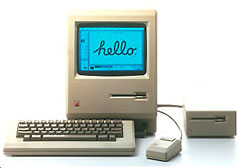Editor's note: Sept. 9, 1998 marks the 9th anniversary of
Charles Moore's first column on Low End Mac (9/9/99). Prior
to that, Charles and I had been part of the MacTimes Network. In honor
of this anniversary, Charles dug up this column, the first Mac
column he ever posted online. We have added some links and images,
edited very lightly, replaced what broken links we can (often with
links to the Internet Archive), and show broken links
with strikethrough text. dk
The Macintosh platform is basking in hardware superiority these
days. The lightning-fast, competitively priced G3 machines eclipse the best
from the PC-compatible world, with their laboring Intel CISC processors
and still-clunky component integration. There is also much appropriate
excitement on the Mac software side with OS 8 raising the bar
several notches higher than did OS 7.x - which Microsoft's Windows 95
had not yet caught up to. Then there is the much-anticipated Rhapsody
OS waiting in the wings.

The Original Macintosh
However, one of the most wonderful things about the Mac is that even
the earliest 128K
and 512K models -
now 14 years old - are still useful, pleasant-to-operate computers,
while your average five-year-old PC/Intel box is most useful as a
doorstop.
For instance, one of my offspring, resident tech-trogolodyte at the
Maccave, has a 512Ke 800
that is still fully operable and in day to day use. The trick with
these old machines is to use software designed for them, in which case
they are still amazingly slick and fast. Contemporary versions of
MacWrite or WriteNow are capable word processors for the type of
writing most people do most of the time. It's hard to convince PC users
that there is a functional and capable 1-bit graphics program
(MacPaint) that will fit on a 400K floppy along with an operating
system! There is even a version (1.5) of Microsoft's Excel spreadsheet
program written for these machines, as well as a respectable selection
of games.
The Mac Plus
A collection of early Mac OS
versions were written to run the 128K (Skinny Mac), the 512K (Fat Mac),
and the Mac Plus from a
single floppy drive. System 0.98 (!) through System 3 will work with
all of them, and the 512Ke and Plus can handle up to System 6.0.8 on
floppies. While the early HD-less Macs can function happily with a
single floppy drive, they are more graceful with two, which cuts down
the need for a lot of floppy switching.
The quietness and speed of these very early, RAM-challenged,
fan-less Macs is a revelation in contrast to their modern descendents
running OS 7.5, 7.6, or 8 and bloated fatware like Microsoft
Office.

The Macintosh SE
A step up from
the very early Macs are the Mac Plus, Mac SE, and Mac Classic. The Plus was a
transition model. It could run from floppies like the 128K and 512K,
but was also equipped with a SCSI bus and port that allowed hookup to
an external HD. The Plus was the first Mac with Mini-DIN 8 serial ports
instead of DB-9 and the last that used the non-ADB mouse inherited from
the Apple ll and Lisa. It came with a larger keyboard incorporating a
numeric keypad and cursor keys and a whopping 1 MB of RAM that
could be upgraded to 2.5 MB or 4 MB. The Plus can run up to OS 7.1
with 2.5 MB of RAM, and up to OS 7.5.5 with 4 MB.
The SE and later the Classic retained the 8 MHz 68000 Motorola CPU
chip but added internal hard drives, cooling fans that helped extend
the video power supply unit's service life, and an ADB bus for input
devices. These Macs shared the Plus's RAM configuration options.
I have a 1988 Mac Plus with a platinum (as opposed to the earlier
beige) colored case. It has been upgraded to 2.5 MB of RAM and has an
external "MacCrate" 20 MB SCSI hard drive. The little hard drive is
partitioned, with OS 7.1 on one side and OS 6.0.8 on the other. This
machine was my first Mac, and I still use it for word processing and 72
dpi line art graphics work. The little 9 inch, 1-bit monochrome monitor
in these one-box machines is small but wonderfully sharp. Software
installed includes MS Word 5.1, MacWrite Pro 1.5, ClarisWorks 3, an
early version of SuperPaint, HyperCard 2.3, and sundry small utility
apps.
Running System 6.0.8, Word 5.1 works very well, although opening,
saving, and spell-checking are sluggish compared with the program's
performance on faster Macs. Word 4 runs happily and speedily on the
Plus, but I miss Word 5.1's drag-and-drop text editing too much to live
without it. I boot from OS 7.1 when I need TrueType fonts for printing,
but otherwise OS 6.0.8 is more than adequate, and significantly faster.
The old Plus will even surf the Internet using the little MacWEB
Browser (regrettably no longer being developed, but still available
for download). Eudora 1.5.1 works great for email.
The street price of these antique Macs is frequently $50 or less,
and they can often be acquired for the asking from people who have long
since moved on to more powerful Macs.
Software for antique Macs can be downloaded from:
http://members.aol.com/maccrypt/index.html
Other antique Mac sites:
The compact Macs were and still are great machines. In terms of
clean and elegant industrial design, nothing Apple has built since
really matches them. The Classics are appropriately named. For more
performance in the same box, there are the 68030 Mac SE/30 and Classic II. The slightly larger and
much more rococo Color
Classic sports a jewel-like 10 inch Sony Trinitron monitor.
Many lament the passing of the compact Macs, but in truth they were
made redundant by another line of phenomenally successful small Apple
computers: the superb PowerBooks.




